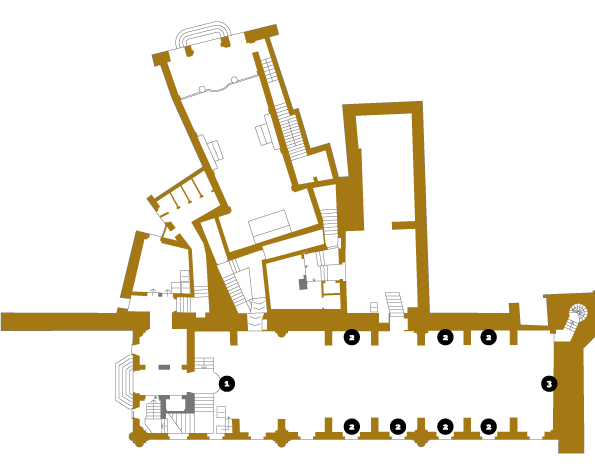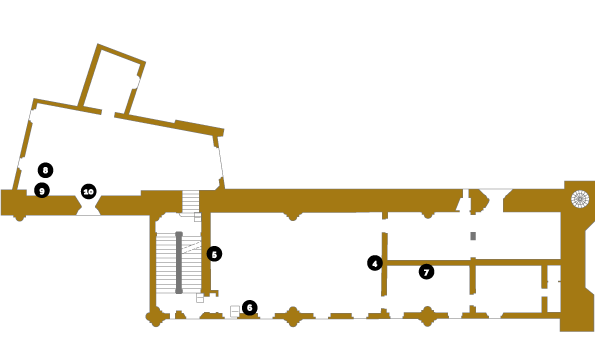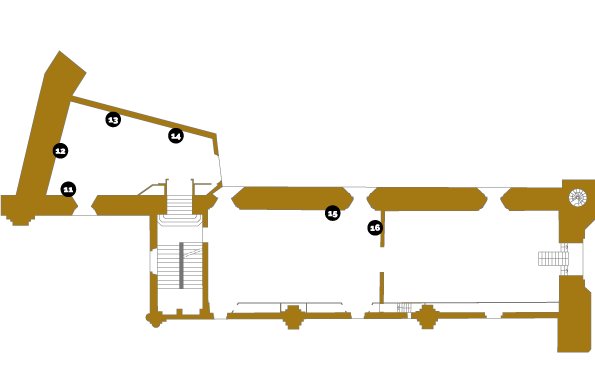As you tour the Cathedral’s museum complex, you will eventually come into the north aisle of the so-called “New Cathedral”. This now houses the Museo dell’Opera, one of the oldest private museums in Italy.
The museum was founded in 1869 and earned the approval of the Education Ministry in an era that witnessed the accomplishment of numerous large-scale projects. The building housing the museum is of immense interest in itself, occupying the first three (now bricked-up) bays of the south aisle of the “New Cathedral”, on which construction began in 1339 but was broken off after the Black Death of 1348.
The ground-floor rooms host a major collection of 14th century Sienese statuary from the Cathedral façade, the first design for which was the work of Giovanni Pisano. The splendid marble statues depicting Sibyls, Prophets and Philosophers of Antiquity, which Pisano carved while holding the post of master-builder (1285–7), vibrate with the artist’s new style of sculpture, coming alive with a Gothic realism and dynamism that pulsates with spiritual energy. The room also contains two important works by 15th century artists: a bas-relief depicting the Madonna and Child Enthroned with Cardinal Casiniby Jacopo della Quercia (1437–8) from the Chapel of St. Sebastian in the Cathedral, and
Donatello’s tondo, a celebrated work depicting the Madonna and Child with Four Cherubs and known as the ‘Madonna del Perdono’(c. 1458) from the original altar of the Madonna delle Grazie in the Cathedral.
The large Stained-glss rose window made by Duccio di Buoninsegna to fill the round “oculus” opening above the Cathedral’s chancel between 1287 and 1290, has been installed at the end of the room. Measuring fully six metres in diameter, the window contains three stories from the life of the Virgin –the Burial, the Assumption and tbe Coronation – in its three superimposedcentral registers, while on either side of the central panel we find depictions of Siena’s four patron saints, St. Bartholomew, St. Ansanus, St. Crescentius and St. Sabinus. The intense blues of the background, the golden yellows, the ruby reds, the amethyst purples and the emerald greens of the figures’ clothing and drapery combine with the delicate pink chosen for their flesh to form an extraordinarily dazzling array of colours.
A temperature-controlled room on the first floor of the Museum is home to the magnificent altarpiece known as the Maestàof Duccio di Buoninsegna, the true jewel in the collection’s crown and an undisputed masterpiece of early 14th century Italian art.
The altarpiece, which Duccio painted from 1308 to 1311, was visible from both sides and is one of the most prodigious artistic undertakings of all time, if we consider that it contains over forty figures on the front and almost eighty in the stories on the back, on the predellas and on the cusps. The panel on the front side depicts the Madonna and Child Enthroned with Angels and Saintswhile the back, which is divided up into twenty-six different scenes, recounts the story of the Passion of Christ. The same room also contains a panel depicting the Birth of the Virginpainted by Pietro Lorenzettiin 1342 for the former alter of St. Sabinus in the Cathedral.
The rooms adjacent to the Room of the Maestà house a rich and prestigious collection of wooden sculptures and illuminated manuscript codices. The statues of Mournerscarved by Domenico di Niccolò dei Cori between 1414 and 1415 and the Madonna and Saintscarved byJacopo della Quercia between 1415 and 1420 are of outstanding quality, while a set of cases in the room houses several of the Cathedral’s numerous codices illuminated by artists of the calibre of Lippo Vanni, Sano di Pietro and Benvenuto di Giovanni.
Treasury
We now move on to the Treasury with its over two hundred objects associated with the sacred liturgy. Its rich collection of chalices includes a superbly enamelled cup made by Goro di Ser Neroccio in the 15th century,
while the star of its splendid collection of reliquaries is the Reliquary of the Arm of St. John the Baptist commissioned by Pope Pius II from Francesco d’Antonio in 1466 to house a relic given to him by the Despot of Morea, Thomas Paleologus. The rare and extremely beautifulcruets from the Chapel of the “Madonna del Voto” in Siena Cathedral are made of rock crystal mounted in silver embellished with translucent enamels. Commissioned by Pope Alexander VII Chigi in the mid-17th century, these cruets may be considered masterpieces of the goldsmith’s art on account of both their highly sophisticated engraving and decoration and of the craftsman’s perfect mastery of his technique. Another product of Chigi patronage is the splendid Golden Rosedesigned by Gian Lorenzo Bernini and donated to Siena Cathedral by Alexander VII in 1658.
The first room contains a collection of chiefly gold-ground paintings, including in particular the Madonna of the Large Eyes, one of the oldest paintings of the Sienese school, painted by the Master of Tressa in the second quarter of the 13th century. The people of Siena offered up a prayer before this picture, entrusting the safety of their city to the Virgin, before the battle of Montaperti on 4 September 1260 (which they went on to win). It is also worthwhile highlighting Gregorio di Cecco’s large polyptych with the Madonna of Humility and Saints (1423) from the Altar of the Visitation in the Cathedral and the two large panel paintings depicting St. Bernardino Preachingpainted by Sano di Pietro in the 1440s.
Alfieri Room
The second room, known as the Alfieri Room, containsMatteo di Giovanni’s two extremely fine altarpieces depicting the Madonna Enthroned with St. Anthony and St. Bernardino (1460) from the Baptistry and the Madonna Enthroned with Four Saints and Angels (1480) from the Celsi Altar in the Cathedral. One of the most original works on display in this room is a panel painting depicting St. Paul Enthronedpainted by Domenico Beccafumiin 1516, together with an elegant pair of polychrome terracotta statues of the Announcing Angeland the Virgin Annunciate which the artist modelled in circa 1545.
Tapestry Room
The Tapestry Room, covered floor to ceiling in 17th century wall hangings, showcases 19th century work such as the large models for the cusps on the Cathedral façade painted by the artists Luigi Mussini and Alessandro Franchi in 1878. Cases around the walls house an important collection of textiles from the Cathedral, while a showcase in the middle of the room contains the precious Casulain Lucca jasper made some time between the 13th and 14th centuries.
GROUND PLAN OF THE MUSEUM
Galleria delle statue:
Position of the masterpieces inside the Museum:
1 Madonna and Child, known as the “Madonna del Perdono”– Donatello
2 Sculptures from the facade of the Cathedral – Giovanni Pisano
3 Stained-glss rose window – Duccio di Buoninsegna

Sala Duccio:
Position of the masterpieces inside the Second Floor of the Museum:
4 Madonna and Child Enthroned with Saints and Angels – Duccio di Buoninsegna
5 The story of the Passion – Duccio di Buoninsegna
6 Nativity of the Virgin – Pietro Lorenzetti
7 Madonna and Child with Saints – Jacopo della Quercia
8 Pastoral ivory – 15th century
9 Reliquary for St John’s arm – Francesco d’Antonio
10 Golden Rose – Gian Lorenzo Bernini (design by)

Sala Madonna Occhi Grossi
Position of the masterpieces inside the Third Floor of the Museum:
11 Madonna of the Large Eyes – Maestro di Tressa
12 Madonna of Humility and Saints – Gregorio di Cecco
13 St Bernardine preaching in Piazza del Campo – Sano di Pietro
15 Madonna and Child Enthroned with St Anthony and St Bernardine – Matteo di Giovanni
16 St. Paul Enthroned – Domenico Beccafumi

OPENING TIMES MUSEUM
From 26 December to 7 January 2025
09:30 am – 7:30 pm
From 8 January to 30 March 2025
10:30 am – 5:30 pm
From 31 March to 2 November 2025
9:30 am – 7:30 pm
From 3 November to 24 December 2025
10:30 am – 5:30 pm
From 26 December to 6 January 2026
09:30 am – 7:30 pm
Last admission 30 minutes before closing time.
CALL CENTER
Information, reservations and ticket sales
+39 0577 286300
TICKETS
Immediate access to the masterpieces of the Monumental Complex of the Duomo, reducing waiting times
A SINGLE TICKET THAT ALLOWS ACCESS TO THE CATHEDRAL ROOFS AND TO ALL THE MUSEUMS OF THE COMPLEX
FULL PRICE
01/03 – 06/01: € 21,00
REDUCED TICKET (CHILDREN FROM 7 TO 11 YEARS OF AGE)
01/03 – 06/01: € 6,00
FREE (CHILDREN UP TO 6 YEARS OF AGE)
Remember to always consult the rules of conduct before accessing the tour.
A SINGLE TICKET THAT ALLOWS ACCESS TO ALL THE MUSEUMS OF THE COMPLEX.
Valid for three consecutive days from the date of issue.
FULL PRICE
01/01 – 26/06; 01/08 – 17/08; 16/10 – 31/12: € 14,00
during floor uncovering
(27/06 – 31/07; 18/08 – 15/10): € 16,00
REDUCED TICKET (CHILDREN FROM 7 TO 11 YEARS OF AGE)
01/01 – 31/12: € 3,00
FREE
- Children up to 6 years of age
- Siena municipality residents and born
- Journalists
- Disabled visitors (+ one carer per visitor)
- Clerics of both genders
- Students of University of Siena and University for Foreigners of Siena
- Parish groups of the Archdiocese of Siena with a letter from the parish priest
* Those born and resident in the Municipality of Siena have free access to the entire monumental complex of the Duomo




